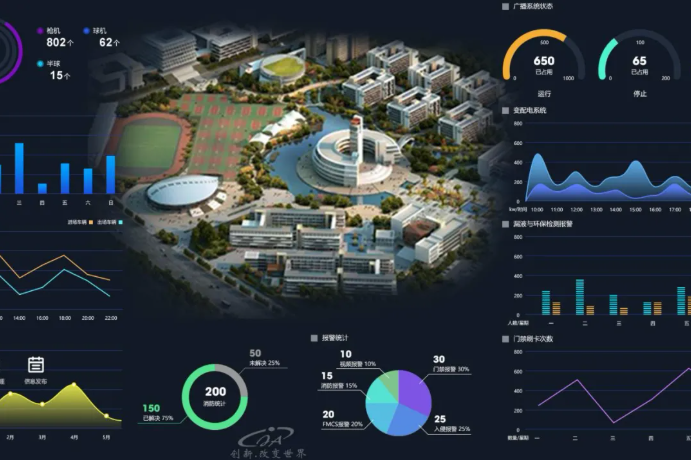In recent years, campus security incidents have been continuously exposed. The country's attention to campus security and the increasing application of information technologies such as artificial intelligence and big data in the education industry have led to the implementation of smart security campuses and smart education in major regions of the country. This year, the construction of 100 smart security campuses was completed in Longgang City, Zhejiang Province alone.
According to the latest data from IDC, by 2020, there will be 31 billion connected devices connected to work in the world. By then, people will experience a continuous, ubiquitous Internet. The primary goal of "smart campus" is to connect various objects in the campus network through IoT technology. Therefore, technically speaking, the construction of a smart campus must involve the use of RFID, QR code, video surveillance, access control, smart buildings and other sensing technologies and equipment.

Traditional campus security monitoring pain points:
The school covers a wide area and the population is relatively mobile. The common safety hazards are as follows:
1. The monitoring efficiency is low. The number of mobile personnel on campus is large, there are many monitoring points, the network bandwidth is insufficient, and the video resolution is not high; the security personnel cannot keep an eye on hundreds of video images at the same time, nor can they guarantee 24-hour effective monitoring; it consumes a lot of labor costs and the accident handling efficiency is low.
2. It is not easy to realize the monitoring network. The school covers a wide area and often expands colleges and universities. The deployment cost of wired monitoring is high, and there are monitoring dead spots in some areas, which are difficult to detect. In addition, the monitoring system is not shared with the public security department, and the one-button alarm is not realized. In the event of an accident, the Emergency ability is not strong.
3. Safety incidents of campus facilities. From dangerous and old buildings, narrow passages, corridors, faulty sports equipment, chemical laboratories, etc.
Smart campus application scenarios
"Dorm keys, drawer keys, classroom keys... a bunch of them, I forget to bring them every time I play basketball, but since I learned about the Internet of Things, I don't have to worry about being 'rejected' because I don't have a key, and my phone can also open the door. ." He shook lightly in front of the access control card reader, and with a beep, the dormitory door opened. In addition to the dormitory door, classroom doors and office doors can be opened through smartphones. At the same time, the school also uses the access control subsystem to manage the cardholder's authority, which greatly improves the security of identification. Entry and exit of the school must be registered, but it was done manually in the past. In the smart campus, the intelligent visitor system will replace the security guard with a series of cumbersome procedures such as checking ID documents, registering, and recording the departure time. Those who come to visit the school only need to hold the certificate and tap on the electronic identification device, and the visitor information can be obtained instantly, and a visitor list will be issued, which greatly speeds up the visitor registration and departure process. At the same time, the face recognition system based on deep learning can realize functions such as visitor registration, course attendance, etc. without carrying any documents...

There are many similar black technologies, which are actually good at companies in the security industry, and are also the basic technologies for safeguarding campus security and building a digital and networked smart campus system.
Smart campus security technology development
At this stage, many colleges and universities have proposed the concept of building a "smart campus", using network resources and integrating the current popular artificial intelligence technology to make school business more transparent and automated, and to integrate campus security systems. Integrate it into school management to create an intelligent, humane and safe campus environment. From the initial civil air defense, material defense, to technical defense, the fundamental starting point of campus security companies and security systems is to ensure the safety of the campus. With the emergence and implementation of new technologies, campus management will be more intelligent and campus life more convenient. A smart campus system with more secure campus security has become a reality.

Nowadays, many security companies with video surveillance related businesses have launched a series of solutions to build a smart and safe campus, including Hikvision, Dahua, Uniview, Keda, STONBEL, Tiandi Weiye and other security protection enterprise. From the front-end Seiko cameras, intelligent analysis systems, visual management platforms to storage. The continuous improvement of the "three defenses" construction makes the needs of the safe campus continue to be met. In addition, with the expansion of security companies' own technology, they are gradually moving towards the field of Internet of Things, and the use of Internet of Things, big data and other information technologies to develop smart campuses has become a major development trend in the future. Security companies can use the leading image analysis technology to intelligently identify the behavior of teachers and students, comprehensively consider the individual characteristics of each individual in the school, and conduct reasonable planning for students' career planning, students' independent course selection, class scheduling, student attendance and comprehensive assessment. Unified planning and management to promote the industry development of intelligent education. At the same time, technologies and products such as biometrics, speech recognition, and educational robots in the field of artificial intelligence have been applied and developed to a certain extent in the field of education. The combination of artificial intelligence and education can not only relieve front-line teachers from heavy and repetitive labor, but also help teachers formulate personalized and customized student learning plans to continuously improve students' desire to learn.

Taking educational robots as an example, in educational scenarios such as schools, the introduction of educational robots can not only serve as assistants and tools for teachers to provide students with teaching auxiliary functions such as managing the learning process and answering frequently asked questions. It can also be used as another study partner for students to provide students with time and task management, promote learning interaction and other aspects of assistance, and promote the healthy growth of students.
5G empowers smart campus security monitoring system
In addition, the development of 5G technology has also given a new development to the smart campus. Relying on the characteristics of wide connection and large bandwidth of 5G network, 360-degree video surveillance points without dead ends are realized in the campus; 4K high-definition video is uploaded to the management center in real time by using the campus private network to realize 7/24-hour all-weather monitoring.
The large bandwidth and low latency of the 5G network make it possible for unmanned mobile inspections. The inspection robots collect surveillance video data of people, vehicles, and equipment on campus, and conduct real-time analysis and processing to identify personnel, vehicle information, Device operating status. Realize network sharing with the public security department, automatically alarm in case of emergencies, and realize campus intelligent monitoring and management.

Using 5G+AI deep learning and image processing technology, it is possible to realize the exchange of face data/models, real-time analysis, monitoring and identification, and tracing of trails. Actively conduct intelligent analysis on the uploaded videos, and set up an "electronic isolation fence" for the whole school. In the event of intrusion, departure, suspicious stay, gathering of crowds, etc., timely intervention in the air and safety warning.
Under the new era background and technological trend, the establishment of Ping An Smart Campus is not only the need for developing high-quality education, but also the need for building a harmonious society today. Undoubtedly, security companies build smart campuses and smart education by using their advantages in innovative applications in the field of artificial intelligence hardware and big data, which will optimize teaching methods and open up a new model of "smart education". In the future, security companies entering the bureau will still need to continue to work hard to strengthen the ability to combine intelligence and practical scenarios in order to take more opportunities in this fierce competition.
Part of the reference source: China Security Industry Network, Longgang News, ofweek, picture source network







